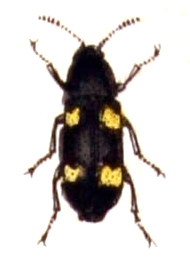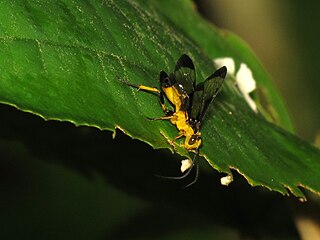In this checklist are presented all wasp species of family Ichneumonidae found within the UK.

Pimpla are a worldwide genus of the parasitic wasp family Ichneumonidae.

Agrothereutes abbreviatus is a species of parasitic wasp belonging to the family Ichneumonidae.

Cryptus is a large genus of wasps in the family Ichneumonidae with 182 described species.

Tromatobia is a genus of ichneumon wasps in the family Ichneumonidae. There are at least 4 described species in Tromatobia. Species in this genus are parasites of egg sacs of spiders from the families Araneidae, Clubionidae, Philodromidae and Theridiidae.

Trogus is a genus of parasitoid wasp found in the Holarctic and Neotropic regions. It is placed in the subfamily Ichneumoninae and the tribe Ichneumonini. Trogus species are parasites of larvae and pupae of the swallowtail butterfly family, Papilionidae. The genus consists of twelve extant and one extinct species.
Nonnus is a genus of parasitic wasps in the family Ichneumonidae. It is the type and only genus of the tribe Nonnini and the subfamily Nonninae.

Epinotia caprana is a moth belonging to the family Tortricidae. The species was first described by Johan Christian Fabricius in 1798.

Exetastes is a genus of parasitoid wasps belonging to the family Ichneumonidae.
Itoplectis is a genus of insect belonging to the family Ichneumonidae.
Astiphromma is a genus of parasitoid wasps belonging to the family Ichneumonidae.
Campoletis is a genus of parasitoid wasps belonging to the family Ichneumonidae.

Selatosomus is a genus of beetles belonging to the family Elateridae. The species of this genus are found in Europe, Japan, southern Africa and North America, and most of the species were formerly included in the genus Ctenicera.

Dircaea is a genus of beetles belonging to the family Melandryidae. The species of this genus are found in Europe, Japan and North America.

Xanthopimpla is a genus of parasitoid wasps belonging to the family Ichneumonidae.
Scolobates is a genus of parasitoid wasps belonging to the family Ichneumonidae.

Linycus is a genus of parasitoid wasps belonging to the family Ichneumonidae. This parasitoid's hosts are typically Geometridae.

Ctenochares is a genus of wasps belonging to the family Ichneumonidae.

Ophion is a genus of ichneumonid wasps, which are nocturnal, parasitic, and often seen at lights. They are mostly orange to yellow in colour and are endoparasites of insect larvae, particularly Lepidoptera. They are very diverse but morphologically very similar. They have a worldwide distribution but the majority of species are found in the temperate zone.

Joppa is a genus of Neotropical parasitoid wasps in the family Ichneumonidae.














